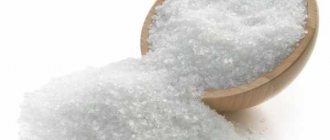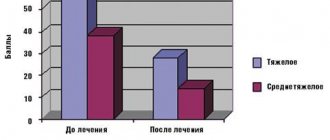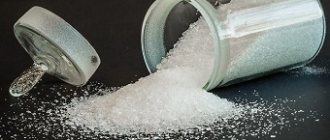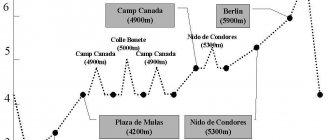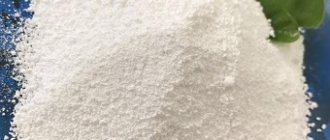When a patient complains of pain in the abdominal cavity or dysfunction of the gastrointestinal tract, the doctor may prescribe an x-ray. Considering the structural features of the abdominal organs, this method cannot be called the most informative. To obtain a clear image, a special contrast agent is injected.
Barium sulfate is used as a contrast agent, which fills all cavities. This powder is poorly soluble in water and is resistant to acids and alkalis, while also having the ability to reflect X-rays. Since barium is not absorbed through the intestinal walls, the possibility of it entering the bloodstream arises only in the presence of open ulcers and other damage to the integrity of the walls. The substance is excreted from the body in feces.
Brief characteristics of barium sulfate:
Barium sulfate is a white inorganic substance.
The chemical formula of barium sulfate is BaSO4.
Barium sulfate is an inorganic chemical compound, a salt of sulfuric acid and barium.
Barium sulfate exists in two modifications (α, β and γ). The α-modification of barium sulfate has an orthorhombic system. The β-modification of barium sulfate has a cubic system. The α-modification transforms into the β-modification at a temperature of 1150 Co.
Practically insoluble in water.
Stable at high temperatures.
Barium sulfate is non-toxic, fire- and explosion-proof.
Barium sulfate is common in nature in the form of the mineral barite (heavy spar).
Indications for radiography
X-ray of the abdominal cavity with barium allows you to study in detail the condition of the stomach and intestines, in particular to see the sections of the small and large intestines, the appendix, and the gall bladder. In the vast majority of cases, x-rays are used for diagnostic purposes or to monitor the effectiveness of therapy.
Phenomena and symptoms in which a patient is advised to undergo an abdominal x-ray with a contrast agent are as follows:
- chronic diarrhea or persistent constipation;
- the presence of blood in the stool;
- suspected internal bleeding;
- sudden weight loss;
- pathological change in the color and consistency of stool;
- chronic or acute pain in the abdominal cavity and lower back;
- suspected internal organ damage;
- abdominal injuries;
- retroperitoneal abscess;
- intestinal obstruction.
In most cases, X-rays using contrast media are preceded by a plain plain X-ray. This is done to ensure that there are no internal damages through which barium can enter the blood.
Physical properties of barium sulfate:
| Parameter name: | Meaning: |
| Chemical formula | BaSO4 |
| Synonyms and names in a foreign language | barium sulfate barium sulphate (barite (Russian) barite white (Russian) |
| Type of substance | inorganic |
| Appearance | colorless rhombic crystals |
| Color | white, colorless |
| Taste | —* |
| Smell | without smell |
| Physical state (at 20 °C and atmospheric pressure 1 atm.) | solid |
| Density (state of matter – solid, at 20 °C), kg/m3 | 2710 |
| Density (state of matter – solid, at 20 °C), g/cm3 | 2,710 |
| Decomposition temperature, °C | > 1600 |
| Melting point, °C | 1580 |
| Molar mass, g/mol | 342,15 |
| Solubility in water (18 oC), g/100 g | 0,00022 |
*Note:
- no data.
Example of problem solution
Four test tubes contain solutions of various substances. A solution of barium chloride was added to each. A precipitate formed in all test tubes. After adding hydrochloric acid, the release of gases began in two test tubes No. 1 and No. 2, and in test tube No. 1 the gas had a pungent odor of burnt sulfur, and in No. 2 it was odorless. In test tube No. 3 the precipitate dissolved, but in test tube No. 4 it remained unchanged. What substances were contained in the test tubes if it is known that the wire dipped into the solutions colored the flame violet? Write the reaction equations.
Solution
Potassium salt flames turn purple.
Test tube No. 1 contained potassium sulfite: BaCl2 + K2SO3 = 2KCl + BaSO3↓; Barium sulfite reacts with hydrochloric acid to release sulfur dioxide (sulfur dioxide):
BaSO3 + 2HCl = BaCl2 + H2O+ SO2↑.
Test tube No. 2 contained potassium carbonate:
BaCl2 + K2CO3 = 2KCl + BaCO3↓.
Barium carbonate reacts with hydrochloric acid to release carbon dioxide (carbon dioxide):
BaCO3 + 2HCl = BaCl2 + H2O+ CO2↑.
Test tube No. 3 contained potassium phosphate:
3BaCl2 + 2K3PO4 = 6KCl + Ba3(PO4)↓.
Barium phosphate dissolves slowly in hydrochloric acid:
Ba3(PO4)2↓+ 6HCl = BaCl2 + 2H3PO4.
Preparation of barium sulfate:
Industrially, barium sulfate is obtained from the natural mineral barite (heavy spar).
In the laboratory, barium sulfate is obtained as a result of the following chemical reactions:
- 1. interaction of barium chloride and sodium sulfate:
BaCl2 + Na2SO4 → BaSO4 + 2NaCl.
- 2. interaction of barium chloride and magnesium sulfate:
BaCl2 + MgSO4 → BaSO4 + MgCl2.
- 3. interaction of barium chloride and copper sulfate:
CuSO4 + BaCl2 → BaSO4 + CuCl2.
- 4. interaction of barium chloride and potassium sulfate:
BaCl2 + K2SO4 → BaSO4 + 2KCl.
- 5. interaction of zinc sulfate and barium sulfide:
ZnSO4 + BaS → BaSO4 + ZnS.
- 6. interaction of sodium sulfate and barium hydroxide:
Na2SO4 + Ba(OH)2 → BaSO4 + 2NaOH.
- 7. interactions between sodium sulfate and barium chloride:
Na2SO4 + BaCl2 = BaSO4 + 2NaCl.
- 8. interactions between sodium sulfate and barium nitrate:
Na2SO4 + Ba(NO3)2 → 2NaNO3 + BaSO4.
- 9. interaction of barium hydroxide and sulfur oxide:
Ba(OH)2 + SO3 → BaSO4 + H2O.
Application
- Barium chloride is used in the production of pigments (eg barite yellow BaCrO4, barium white BaSO4 and Cassel green BaMnO4).
- It is used as an additive to electrolytes in the production of Mg.
- Used for hardening high-speed steel (in the form of melts of a mixture of BaCl2 with chlorides of alkali and alkaline earth metals).
- In the leather industry to make leather heavier and brighter.
- In the paper industry for weighting paper for printing banknotes.
- In medicine, it is used as contrast for X-rays.
Chemical properties of barium sulfate. Chemical reactions of barium sulfate:
The chemical properties of barium sulfate are similar to those of other metal sulfates. However, barium sulfate does not react with acids or alkalis. Therefore, it is characterized by the following chemical reactions:
1. reaction between barium sulfate and carbon:
BaSO4 + 4C → BaS + 4CO (t = 1100-1200 °C),
BaSO4 + 3C → BaS + CO2 + 2CO (t°).
As a result of the reaction, in the first case, barium sulfide and carbon (II) monoxide are formed, in the second, barium sulfide, carbon monoxide (IV) and carbon monoxide (II).
2. reaction between barium sulfate and hydrogen:
BaSO4 + 4H2 → BaS + 4H2O (t = 900-1000 °C).
As a result of the reaction, barium sulfide and water are formed.
3. reaction between barium sulfate and sodium hydroxide :
2BaSO4 + 2NaOH ⇄ (BaOH)2SO4 + Na2SO4 (t = 20-40 °C).
As a result of the reaction, barium hydroxysulfate and sodium sulfate are formed. The reaction uses a concentrated, cold solution of sodium hydroxide. The reaction is reversible.
4. thermal decomposition reaction of barium sulfate:
2BaSO4 → 2BaO + 2SO2 + O2 (t > 1600 °C).
As a result of the reaction, barium oxide, sulfur (IV) oxide and oxygen are formed.
Preparing for the study
The information content of the result depends on the accuracy of compliance with all the rules of preparation for radiography using a contrast agent. During a planned procedure, the patient is prescribed a special diet with a limitation of foods that cause increased gas formation - 3 days before the study. Additionally, the doctor prescribes medications with a laxative effect and describes a regimen for taking them. Two days before an X-ray with barium, you should exclude alcoholic beverages, coffee and tea from your diet, and it is advisable to completely stop smoking. In the last 24 hours before the diagnosis, you should not eat solid food - you can drink broths, herbal teas, and still water.
During the preparation period, taking medications is not recommended. If complete abstinence from medications is not possible, you should drink plenty of water with each dose of medication.
Immediately before the procedure, the patient needs to change into suitable clothes - his own or hospital clothes. It is also worth removing all metal objects, including removable dentures.
What is
Barium is a chemical element occupying cell 56 of the periodic table:
- Initially, it is a soft, plastic substance with a viscous structure and a silvery color.
- Refers to alkaline earth metals.
- Like other elements in this segment, it is endowed with increased chemical activity.
- The composition is a conglomerate of seven stable isotopes. Two thirds (72%) are Ba138. Radioactive isotopes have been synthesized.
The most popular artificial isotope is Ba140. This product of uranium-thorium-plutonium decay serves as a marker of radioactivity.
International designation – Ba (Barium).
Warning
The effect of the substance on humans can be dangerous.
Barium and its soluble salts are toxic:
- Poisoning occurs when the safe concentration is exceeded.
- Soluble salts are especially dangerous. Once in the gastrointestinal tract, they are “released”. Then they cause cardiac paralysis and death within a few hours.
- Severe poisoning (ingestion of 0.19-0.49 g of soluble metal salts) results in death within 24 hours. 0.79-0.89 g causes instant death.
- Symptoms of barium intoxication include disturbances in speech, vision, and gait due to muscle paralysis. Plus dizziness, shortness of breath, tinnitus.
Metal leaves a chemical burn on the skin and mucous membranes.
According to Russian standards, barium belongs to hazard class 2. A cubic decimeter of water (volume 10x10x10 cm) cannot contain more than 0.7 mg of the substance.
Where is it used?
The utilitarian characteristics of the metal (ductility, malleability, toughness) ensured its demand among industrialists and scientists. More often these are compounds and alloys than pure metal. Area of use - from nuclear power plants to fireworks displays.
Atom, chemistry
The material is in demand in serious industries:
- Current sources (chemical) . Fluoride is a component of the electrolyte in fluorionic batteries, oxide in copper batteries, and sulfate in lead-acid batteries.
- Superconductors. A mixture of oxides of barium, copper, and rare earth elements is an ingredient in the production of superconductor ceramics.
- Atomic industry . The oxide is added to the glass lining of the uranium rods.
It is a component of the “shield” of X-ray and nuclear installations. This is how the metal’s ability to attract x-rays and gamma rays is used.
Other industries
Metals and alloys (especially with aluminum) have found application in the civilian segment:
- Gas “absorber” in high-vacuum electronics.
- Additive (with zirconium) to coolant fluids to increase the corrosion threshold (pipelines, metallurgical equipment).
- In metallurgy, it is a deoxidizer, a purifier of copper and lead from impurities.
- Fluoride is the basis of lenses, prisms, and other optical products.
- Barium-nickel alloy is the material of electrodes for engine spark plugs.
Barium in a test tube
Compounds of the element are in great demand:
- Peroxide. Source of bleach for silkworm fibers, cotton, wool. Disinfector.
- Sulfide. Destroyer of hair from animal skins.
- Perchlorate. Top dehumidifier.
- Chromate, manganate. Yellow and green pigments in paint and varnish production.
Nitrate and chlorate create the green lights of fireworks and other pyrotechnic spectacles.
Non-industrial segment
Carbonate kills rodents.
Sulfate is in demand in medicine. It is non-toxic and is used as a contrast material in gastrointestinal examinations.
History of discovery.
Also on topic:
BARITE
In 1602, Casciarolo (Bolognese shoemaker and alchemist) picked up a stone in the surrounding mountains that was so heavy that Casciarolo suspected it was gold. Trying to isolate gold from a stone, the alchemist calcined it with coal. Although it was not possible to isolate gold, the experiment brought clearly encouraging results: the cooled calcination product glowed reddish in the dark. The news of such an unusual find created a real sensation in the alchemical community and the unusual mineral, which received a number of names - sunstone (Lapis solaris), Bolognese stone (Lapis Boloniensis), Bolognese phosphorus (Phosphorum Boloniensis) became a participant in various experiments. But time passed, and gold did not even think of standing out, so interest in the new mineral gradually disappeared, and for a long time it was considered a modified form of gypsum or lime. Only a century and a half later, in 1774, the famous Swedish chemists Karl Scheele and Johan Hahn carefully studied the “Bologna stone” and found that it contained some kind of “heavy earth”. Later, in 1779, Guiton de Morveau named this “land” barote (from the Greek word “barue” - heavy), and later changed the name to baryte (baryte). Under this name, barium earth appeared in chemistry textbooks of the late 18th and early 19th centuries. For example, in the textbook by A.L. Lavoisier (1789), barite is included in the list of salt-forming earthy simple bodies, and another name for barite is given - “heavy earth” (terre pesante, Latin terra ponderosa). The still unknown metal contained in the mineral began to be called barium (Latin - Barium). In Russian literature of the 19th century. The names barite and barium were also used. The next known barium mineral was natural barium carbonate, discovered in 1782 by Withering and later named witherite in his honor. Barium metal was first prepared by Englishman Humphry Davy in 1808 by electrolysis of wet barium hydroxide with a mercury cathode and subsequent evaporation of mercury from barium amalgam. It should be noted that in the same 1808, somewhat earlier than Davy, barium amalgam was obtained by the Swedish chemist Jens Berzelius. Despite its name, barium turned out to be a relatively light metal with a density of 3.78 g/cm3, so in 1816 the English chemist Clark proposed rejecting the name “barium” on the grounds that if barium earth (barium oxide) is indeed heavier than other earths ( oxides), then the metal, on the contrary, is lighter than other metals. Clark wanted to name this element plutonium in honor of the ancient Roman god, ruler of the underground kingdom of Pluto, but this proposal did not meet with support from other scientists and the light metal continued to be called “heavy.”
Analogs
Barium sulfate substitutes - Bar-Vips and Adsobar.
Bar-Vips
Manufacturer – Vips-Med, Russia
Price – from 110 rubles
Description – the powder from which the suspension is prepared is used for x-ray examination of the digestive organs. In this case, conventional diagnostics or double contrast is used
Pros - the drug has low toxicity, the powder is not absorbed into the general bloodstream, the suspension has good X-ray contrast characteristics
Disadvantages - cannot be used in children; after use, allergic reactions often develop and discomfort occurs in the epigastric zone.
Adsobar
Manufacturer – Pharmzaschita NPC FMBA/Moskhimfarmpreparaty, Russia
Price – from 100 rubles
Description – the powder is used for fluoroscopy of the digestive organs, including the double contrast technique
Pros – makes diagnostic testing more informative, has low toxicity, does not penetrate into the systemic circulation
Disadvantages - after using the suspension, allergies and unpleasant symptoms from the gastrointestinal tract occur, there are contraindications, it can affect the absorption of other drugs.
